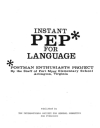Want to Teach General Semantics?
You will find the following resources helpful when designing lessons for classes in general semantics. Skilled teachers in general semantics have contributed teaching guides for students of all ages, syllabi, course materials, tutorials, exercises, and handouts.
Also included are links to books that aid in the instruction of general semantics.
Teaching Guides
Lecture Notes on Teaching General Semantics
by Lance Strate, Ph.D.
This excellent and detailed outline used for teaching general semantics Dr. Strate employed for many years in his course introducing students to the field of communication. In this outline, he presents general semantics “on its own terms, as a separate topic and unit.” Of note, Dr. Strate bridges general semantics to other communications fields, making for a contextual understanding of general semantics in the field of communication.
A Continuing Education Guide to Teaching General Semantics
by Martin H. Levinson, Ph.D.
This guide contains twelve continuing education lessons in general semantics. Each lesson includes an Introduction (for the teacher) of the basic GS ideas to be presented, a Motivation to begin the lesson, and Suggested Activities for students. Lessons can be combined or abbreviated depending on the time constraints of the course and wishes of the instructor.
Awareness & Action: A General Semantics Approach to Effective Language Behavior
by Mary P. Lahman, Ph.D.
This ebook aims at increasing awareness of faulty language behavior and motivating daily action to correct such behavior. In the first two sections of this text, Dr. Lahman shows how general semantics can be used as a systematic inquiry into language behavior. In the remaining four sections, Dr. Lahman follows with an application of these formulations, including case studies.
Twelve General Semantics Lessons for Middle School Students
by Martin H. Levinson, Ph.D.
This curriculum provides twelve science-based general semantics lessons for middle school students. It was developed as part of a research study that used the ideas and techniques of general semantics to reduce feelings of alienation among seventh-, eighth-, and ninth-grade students.
Seminar: Language, Thought and Culture
by Eva Berger, Ph.D.
This syllabus (in Hebrew) outlines a seminar that deals with the relationship between symbols, brain, meaning, language, thought, and culture. The first goal of this seminar is to stimulate students’ thinking about the ways in which symbols, especially language, are involved in the process of human thinking and behavior. The second goal is to help students hone their critical thinking, which is closely related to language.
 Course Materials
Course Materials
Seminar-Workshop Participant Notebook
from June 2006
The following materials come from the June 2006 Seminar-Workshop participant notebook. They include an abundance of lessons and instruction for teaching and learning general semantics.
Seminar-Workshop Notebook Materials
These materials come from the June 2006 Seminar-Workshop participant notebook. They include an abundance of lessons and instruction for teaching and learning general semantics.
Tutorials, Exercises & Handouts
Language Revision Worksheet
by Ben Hauck
This worksheet provides students with examples of different examples of problematic speech — from exaggeration, to lack of consciousness of abstracting and the general semantics recommendations to treat them. Students have the opportunity to revise problematic statements with their own general semantics solutions.
Four Kinds of 'Science'
by Stuart A. Mayper & Robert P. Pula
This worksheet is used for discussions of the epistemology of science as a human issue.
The following worksheet, prepared by Dr. Stuart Mayper and Robert Pula for use at Institute Seminar-Workshops, is used for discussions of the epistemology of science as a human issue. The sheet represents a mere summary of points raised and debated at joint sessions conducted by Mayper and Pula which are designed to sharpen awareness of formulations and orientations which subtend Korzybski’s system. An aspect of the session is the application of general semantics formulations to general semantics formulations, including investigation of the degree to which general semantics can be evaluated as an empirical science in the predictive as opposed to the merely descriptive sense. – Ed.
I. Accepted ScienceTheories that are not yet refuted, after rigorous tests. Counterexamples must be accounted for or shown to be in error. Theories “tentative for ever”, but not discarded frivolously. Good replacements are not easily come by. A new theory must account for not only the data that the old theory doesn’t, but also all the old data that the old theory does. II. Erroneous ScienceTheories that are not yet refuted, but are tested by false data: (a) Fake Science — scientist intentionally deceives others: Cyril Burt, John Darsee, Piltdown man, Walter Levy (Rhine’s successor at Duke); (b) Mistaken Science — scientist unintentionally deceives self (and others): Blondlot (N-rays), Psi investigators, Wilhelm Reich, etc. | III. PseudoscienceTheories inconsistent with accepted science, attempts to refute them avoided or ignored: Astrology, Numerology, Biorhythms; Velikovsky; Dowsing, Health Frauds: Krebiozen, Laetrile, Vitamin B-15, “Life Extension”, Psychic Surgery — Diagnosis by: iridology, blood spot or hair, Kirlian photography, etc. Wild extensions of accepted scientific findings (usually not by the one who made them): some interpretations of Bell’s inequality, plant communication, etc. IV. Fringe ScienceTheories inconsistent with accepted science, not yet refuted, but attempts to do so invited: Unified field theories (data accumulate faster than theory construction), Rupert Sheldrake’s “morphogenetic fields”, Schmidt’s ESP findings, etc. |
Free Web Books
Instant PEP for Language | Words and What They Do to You |
 Books in the IGS Store
Books in the IGS Store
Classroom Exercises in General Semantics | Teaching General Semantics: A Collection of Lessons Plans for College and Adult Classes | General Semantics: An Outline Survey |





